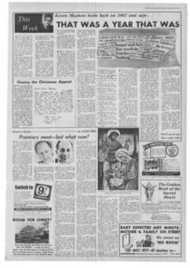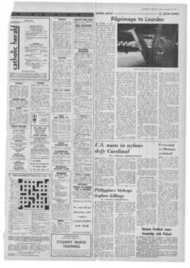Page 6, 29th December 1967
Page 6

Report an error
Noticed an error on this page?If you've noticed an error in this article please click here to report it.
Tags
Share
Related articles
The English Mass: Have We Lost Too Much And Not Gained...
On The Screens By Freda Bruce Lockhart
Films By Freda Bruce Lockhart
The Book On Suffering
Pastor Luventus Petty Laws In The Land Of The Free
BEST OF THE YEAR
SITTING down to recall the memorable moments of 1967, I find that spontaneous memory, prodded by lists, brings an instant welcome surprise. Instead of having to analyse trends and find enough examples of them to fill a quiver of a dozen or so distinguished films, I find myself this year with three comfortably far ahead of all the rest. These three easy winners, still more remarkably, could all be described as of specific Catholic interest.
Fred Zinnemann's film of Robert Bolt's A Man for All Seasons must surely, by fairly common consent, be rated the film of the year. It swept away almost every imaginable Academy award; in London it is still filling the cinema where it opened. Neither in its authorship nor in its treatment is it a Catholic film, but the whole essence of it is Catholic.
Its hero, St. Thomas More, was the Catholic Englishman par excellence, his story could hardly be more Catholic: that of a great wordly figure who laid down his life for his faith, going to the block rather than let his Catholic loyalty be corrupted by the so-called reformers and enemies of the Church.
The second film of paramount Catholic interest in 1967 was of course Pasolini's The Gospel according to St. Matthew. I should put it first but that the Italian "dialogue," the film's great length and its severity make it unlikely to be quite as prominent in the ordinary cinema. I know there is some controversy about the degree of its perfection. But the cinema is unlikely for a long time to see another such almost-documentary version of the Gospel.
The third great Catholic film was Balthasar, Robert Bresson's beautiful, poignant film of the donkey suffering for the cross on his back. "Balthasar" really came on at the turn of the year—always a difficult time to make assessment. But from a year's retrospect it still looks the perfect Christian fable.
A film similarly timed at this end of the year, which I am tempted to put fourth is Dr. Dolittle, which I reviewed here with almost unreserved enthusiasm last week. If I had to decide a "best actor award" between Rex Harrison as Dolittle and Paul Scofield as Sir Thomas More, I should be very hard put to it.
With my fifth, Antonioni's Blow-up I am on more unsure, controversial ground. But I long ago recognised that Antonioni is one of those divisive directors about whom it is pointless to argue. Those who don't like his work find it mannered, pretentious, unintellible. Others, like me, may not understand his language or his message (if any), but find he makes films as films should be made. Until more film-makers do so, I shall continue to follow Antonioni.
With "Blow-up" we are verging on one of the year's marked trends: to make movies obscure in content and involved in form — or Purposely puzzling and fragmentary in form. Of this new movie "impressionism" Jean-Luc Godard is perhaps the most practised exponent.
Of his essays in this style, I preferred Ma_sculin-Feminin, a lively type of on-the-spot magazine review. But there were many ventures and experiments in this field. Much the most mature, the one that came off best, was British Accident, made by Joseph Losey and starring Stanley Baker and Dirk Bogarde. This fine film succeeded in being constantly exciting without striving after sensationalism; a satisfying
film, rewarding to see more than once.
Others which ventured more or less successfully into these depths of chronological anarchy, just a little beyond oldfashioned flashback, were the attractive French Un Homme et Une Femme whioh also introduced technical innovations in the narrative use of colour; and the German, Yesterday Girl which turns the experiments with time to fascinating human and historical documentary account.
Two British attempts to use these new methods to enlarge the film's area of communicar tion were Peter Whitehead's lively Tonite Let's All Make Love in London; and Truffaut's more difficult Fahrenheit 451 with Julie Christie and Oskar Werner. Neither of the last two films quite makes my top dozen, but are too interesting to forget.
Pleasure in three other movies last year persists perhaps beyond cold critical reason: Bonnie and Clyde, the singularly brutal little gangster glimose of the 20's, fascinating for its dual perspective of then and now; the Polish Barrier, very difficult and possibly pretentious but perhaps taking the cinema over the top into poetry where only Cocteau has made it flourish.
And my last acclaim goes for pure light relief to the very happy English comedy starring Michael Crawford, The Jokers —just a cut above the "Carry On" series.
So : few big stars, no great Western, no great musicals. Best of the Swedish "X"-es, My Sister, My Love almost makes the team on quality alone. Spy films fizzled on, best I thought The Quiller Memorandum starring Alec Guiness. James Bond went out (it seems) with a flourish in You Only Live Twice. My least favourite new trend was the introduction of European Westerns, as A Fistful of Dollars and For a Few Dollars More.
At the last moment of the year an outsider which would have come very near the top of the list is Bedazzled ("A", Carlton). The brilliant Peter Cook-Dudley Moore comedy, surprisingly e n o u g h, also comes into the category of Catholic interest.
blog comments powered by Disqus









